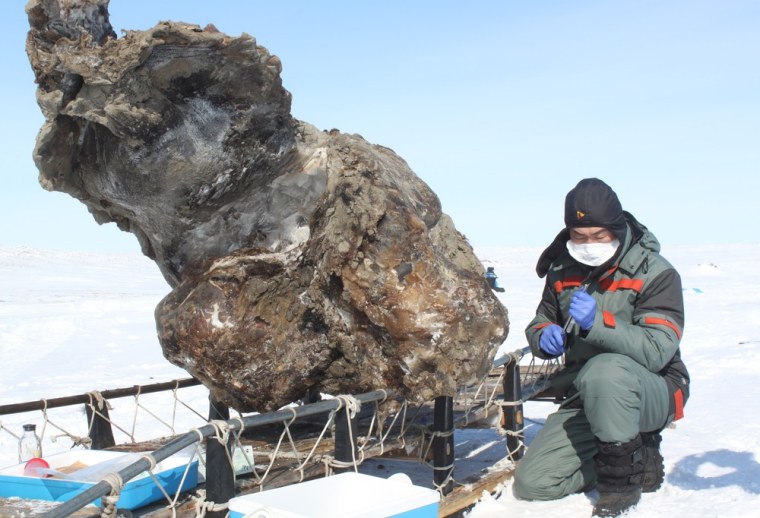Mammoth blood? Siberian discovery sparks some wild and woolly claims
Russian researchers say they've recovered blood samples from a 10,000-year-old mammoth carcass found in Siberia, but outside experts are skeptical about the claims — and particularly about suggestions that the mammoth can be cloned."What makes the news here is that they have the liquid," Stephan Schuster, a biologist at Penn State who helped decode the woolly mammoth genome several years ago, to

Russian researchers say they've recovered blood samples from a 10,000-year-old mammoth carcass found in Siberia, but outside experts are skeptical about the claims — and particularly about suggestions that the mammoth can be cloned.
"What makes the news here is that they have the liquid," Stephan Schuster, a biologist at Penn State who helped decode the woolly mammoth genome several years ago, told NBC News. "But this could also be water that is now thawing and is running out with organic compounds that are in the carcass."
The research team from North-Eastern Federal University in the Siberian city of Yakutsk says it's blood.
"The blood is very dark," Semyon Grigoriev, who headed the expedition to the Lyakhovsky Islands in the Siberian Arctic, said Wednesday in a university news release.
"It was found in ice cavities below the belly, and when we broke these cavities with a poll pick, the blood came running out. Interestingly, the temperature at the time of excavation was -7 to -10 degrees C [14 to 19 degrees Fahrenheit]. It may be assumed that the blood of mammoths had some cryoprotective properties," he said.
It's difficult for Schuster or other outside experts to render judgment on the claims, since the only information available on the find is what's in the press. "I have no doubt that they have found something interesting, but what exactly it is ... is hard to say at this moment," Daniel Fisher, an expert on mammoths at the University of Michigan, told Scientific American's Kate Wong.
Schuster said it's conceivable that the fluid contains natural antifreeze. Experts have found that to be the case for lots of modern-day organisms in chilly environments. "It could come from the breakdown of biopolymers," he said. "You have a lot of small organic components that would have the properties of being cryoprotective."

The Russian reports suggest that the partial female carcass is unusually well-preserved. Fragments of the mammoth's muscle tissues "have a natural red color of fresh meat," Grigoriev reported. That's not unprecedented, however. There have been numerous reports about the recovery of mammoth meat that's good enough to eat.
The big question focuses on what you can do with that preserved tissue and blood (or bloodlike goop).
"What they are saying without saying it is, 'Oh, if we have blood, then the rest of the carcass might yield clonable DNA," Schuster said. After all, Grigoriev is one of the leaders of the Russian-Korean "Mammoth Miracle" cloning project. He's quoted as saying that the carcass had to be recovered in cold weather, "because the unique discovery would melt in summer or autumn, and the priceless material for the joint project 'Mammoth Rebirth' ... could disappear from thawing and wild animals."
The scientists who are working on the project have said a woolly mammoth could be cloned sometime in the next five years, but Schuster and other researchers involved in studying mammoth genetics are skeptical that there'd be enough intact DNA in any thawed-out sample to do the deed. So far, the best places to find mammoth DNA have been from the teeth, bones and hair rather than from the muscles or tendons — and even then, the pickings have been slim.
"None of us has ever seen a sample from a mammoth where the genome has not been completely shattered," Schuster said. "The maximum we find is 100 base pairs, maybe 400 base pairs. You would need on the order of millions of base pairs, and there's no such thing."
Even if the DNA isn't intact, it may still be possible to extract proteins from the tissues, just as proteins were extracted from the fossilized bone of a Tyrannnosaurus rex several years ago. Schuster said working toward that goal would be exciting as well as realistic.
"The case is rare enough, that everything inside the carcass needs to be investigated in the fullest," he said. "Only after this has been done can we assess whether this find will really advance our understanding of the biochemical makeup of a mammoth. But I am less optimistic about learning more about the genetic makeup."
More about mammoths:
- Discredited scientist leads mammoth effort
- Primo mammoth found, but it can't be cloned
- Cosmic Log archive on mammoths
Alan Boyle is NBCNews.com's science editor. Connect with the Cosmic Log community by "liking" the NBC News Science Facebook page, following @b0yle on Twitter and adding the Cosmic Log page to your Google+ presence. To keep up with NBCNews.com's stories about science and space, sign up for the Tech & Science newsletter, delivered to your email in-box every weekday. You can also check out "The Case for Pluto," my book about the controversial dwarf planet and the search for new worlds.